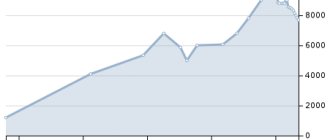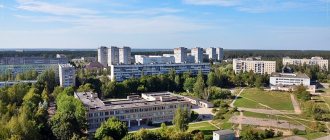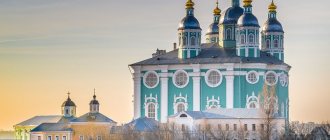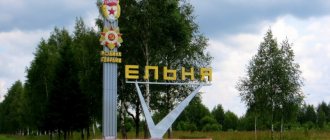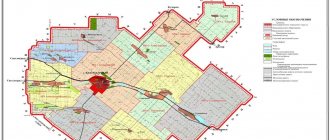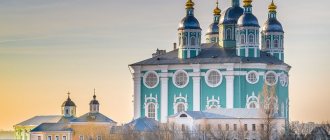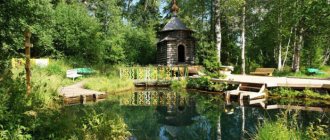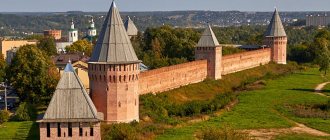For other places with the same name, see Sychevka.
City in Smolensk region, Russia
| Sychevka Sychevka | |
| City [1] | |
| In Sychevka | |
| Coat of arms | |
| Location of Sychevka | |
| Sychevka Location of Sychevka Show map of Russia Sychevka Sychevka (Smolensk region) Show map of Smolensk region | |
| Coordinates: 55°50'N 34°17'E / 55.833°N Latitude 34.283°E / 55.833; 34 283 Coordinates: 55°50'N 34°17'E. / 55.833°N Latitude 34.283°E / 55.833; 34 283 | |
| A country | Russia |
| Federal subject | Smolensk region [1] |
| Administrative region | Sychevsky district [1] |
| urban village | Sychevskoe [1] |
| First mention | 1488 |
| City status from | 1776 |
| Square [1] | |
| • General | 11.03 km 2 (4.26 sq mi) |
| Height | 200 m (700 ft) |
| population size (2010 Census) [2] | |
| • General | 8,111 |
| • Evaluate (2018) [3] | 8 220 ( + 1,3% ) |
| • Density | 740/km2 (1,900/sq mi) |
| Administrative status | |
| • Capital from | Sychevsky district [1], urban settlement Sychevskoe [1] |
| Municipal status | |
| • Municipal district | Sychevsky municipal district [4] |
| • Urban village | Urban settlement Sychevskoye [4] |
| • Capital from | Sychevsky municipal district [4], urban settlement Sychevskoe [5] |
| Timezone | UTC+3 (MSK[6]) |
| Postal code [7] | 215279, 215280 |
| OKTMO ID | 66646101001 |
Sychevka
(Russian: Sychevka) is a city and the administrative center of Sychevsky District in Smolensk Oblast, Russia, located between the Vazuza and Losmina rivers, 234 km (145 mi) northeast of Smolensk, the administrative center of the region. Population: 8,111 (2010 census); [2] 8683 (2002 census); [8] 9,643 (1989 census). [9]
History[edit]
It was first mentioned in 1488 as the patrimony of Tver Prince Ivan the Young, son of Ivan III. [ citation needed
] In 1493 it became a palace village in Vyazminsky district.
In 1776, Sychevka was given the status of a city. [ citation needed
] During World War II, the city was occupied by the German army from October 10, 1941 to March 8, 1943, when it was liberated by troops of the Soviet Western Front.
On January 7, 1943, the city's Jews were killed in a mass execution carried out by the Einsatzgruppen. [10]
Description of the city: 1801
Sychevsk, a district city of the Smolensk province, lies at 55 degrees 42 minutes north latitude and 52 (32) degrees 33 minutes longitude, the distance from Moscow is 219, St. Petersburg 725 (723) and from Smolensk 227 versts. Its position is along the flow of the Vazuza River on the left, and the Losmina River on the right side. It was built again according to the highest confirmed plan, located along the slopes in an irregular figure, having a circumference of 5 versts and bounded on the eastern and southern sides by the Vazuza River and the western Losmina River, and on the northern and partly southwestern by an earthen rampart and ditch. Here, at the exits to the roads leading to the cities of Vyazma, Belaya, Rzhev and Zubtsov, there are four wooden outposts called: Vyazemskaya, Belskaya, Rzhevskaya and St. Petersburg. This City, which was formerly the village of Sychevki, according to the highest order of Her Imperial Majesty, blessed and eternal glory worthy of the memory of the Empress Catherine II, was established in 1779. inside this City there are churches: 1) Cathedral - stone, in the name of the Ascension of the Lord, with two chapels of St. Nicholas the Wonderworker and the Holy Martyr Theodore Stratilates. Around this church there is a stone fence with a chapel, at the corners of which on the southern side there are two more stone buildings, of which the spiritual Board is located in one, and the almshouse in the other. 2) Outside the city in the cemetery there is a wooden Nativity of the Blessed Virgin Mary. State buildings 1) A stone building in which there are two floors, of which the upper one houses the district and Lower Zemstvo courts, and the lower one houses the City Council, the Magistrate, the Verbal and the Orphan's courts. 2) The storage room for the treasury and the Archive are made of stone. 3) The stone building where the Mayor lives and the county Treasury and the School are located, where youth are taught Russian reading and writing, Christian law and Arithmetic. 4) Four wooden shops, of which two are salt shops and two are wine shops. 5) Five wooden drinking houses. Philistine building: Wooden houses ————“————“———— 313 Fryazhsky wooden cellars. ————“————“———— 1 Wooden tavern ————“————“———— 5 Benches for selling stones. “————“———— 5 government goods wooden “———— “———— 20 Barns for storing various wooden grains. ——-«———— 35 Wooden forges. ————«————«———— 6 Wood breweries. ————«————«———— 1 Factories for linen, clothes yarn, wood. ——-«———— 1 On top of this there is also an Infirmary and a wooden courtyard. Built by the local merchants and philistines, some of whom include runaway convicts. Two flour mills, one with four, and the other with three sets, wooden, given from the city Magistrate as quitrent, are located on the Vazuza River and are active during all yearly periods, except during low water. Big streets: 1. Soldatskaya 2. Belskaya 3. Rzhevskaya 4. St. Petersburgskaya Of these, there are 21 exiting lanes, each of which is called by name, such as: 1, Golitsynskaya; 2, Ekaterininskaya; 3, St. Petersburg; 4, Ziminskaya; 5, Kuznechnaya; 6, Square; 7, Artemovskaya; 8, Nikolskaya; 9, Artemovskaya; 10, Yakovtsovsky; 11. Lower; 12, Pavlovskaya; 13, Popovskaya; 14, Upper; 15, Aleksandrovskaya; 16, Burtsovskaya; 17, Losminskaya; 18, Voznesenskaya; 19, Vyazemskaya; 20, Melnichnaya; 21, Maltsovskaya. Residents in this City: Male. Women Headquarters and chief officers 22 19 Clergy and clergy 76 74 Clerks 29 20 Merchants of the 2nd and 3rd guilds 271 236 Bourgeois 450 425 Servants and retired soldiers 51 43 Household people 70 22 Total of both sexes 1768 people Some local merchants and townspeople trade in silk , paper, wool and other various small goods, as well as food supplies; while others buy and sell various types of bread, hemp, flax, cow butter, linseed oil, hay, honey and goose down. Some maintain inns. from which, by selling hay, oats, tar and other things, passing merchants receive satisfied benefits, while others are engaged in fishing, shoemaking, carpentry, and blacksmithing. Women practice ordinary household needlework. They have cattle breeding only for their own consumption, and even then in small quantities. Fairs in this city annually, and even then small ones, take place after Easter on the day of the Ascension of the Lord and December 6th, to which merchants from the cities of Vyazma, Gzhatsk, Rzhev, Zubtsov and Smolensk come with cloth of various materials and other small goods, and weekly auctions every week twice on Friday and Sunday, some of the surrounding villages bring various grains, flax, hemp, honey, food supplies, hay, firewood and other various village products for sale. Local residents get enough salt from Nizhny Novgorod stores. This city is abundant in water and the water is very healthy for people and livestock. The Vazuza River flowing here, through which the ferry service and the Losmina River operate, in the hottest summer time are: the first is from one and a half to two arshins deep, twenty fathoms wide, and the other is half an arshin deep, one and a half fathoms wide, in which fish are caught: pike, chub, ide, burbot, roach, perch, ruff and minnows, and occasionally catfish; Fishing on them always happens in the spring, although the development of water from them does occur, but no harm is caused to the city. The mentioned river and river freeze at the beginning of November, and open up at the end of March and early April. The soil in this city is silt and sand, which produces vegetable fertility in sufficient quantities in vegetable gardens. The land under the settlement of the city of Sychevsk consists, according to the projected plan, of 101 dessiatines 300 square fathoms, including inconvenient places 11 dessiatines 500 square fathoms. Owners: Sychevka from 1488, when it was recaptured from the Vyazma prince Vasily Byvalitsky by Tsarevich Ivan the Young, until 1691 it was a palace village. This year, Tsar Peter I gave half of Sychevka to the boyar Alexei Ivanovich Naryshkin, but then took his gift back in 1724 for the boyar’s misconduct - he did not appear on time to the tsar. Since then, no one else owned such large property in Sychevka; there were many different small owners. Churches: Cathedral of the Ascension of the Lord - History - built on the site of the ancient St. Nicholas Church in 1759-1775 - probably built by Ostashkov craftsmen. A good example of provincial baroque with decor in the Naryshkin style, reproducing the forms of the Transfiguration Church of Ostashkov, with chapels: Nikolsky and Theodore Stratelates. Built by the Naryshkins. 1759 - the main altar is illuminated. 1778 - an antimension was issued to the chapel in the name of St. Vlkm. Theodore Stratelates 1826 - antimensions were issued to the chapels of Theodore Tyrone and St. Nick. Miracle. 1936 - closed, destroyed during the war. The remains of the refectory (?) dating back to the end have been preserved. XIX - early 20th century, built into the gymnasium of a city school. 09/10/1936 - closed and occupied by the military department 1943 - blown up by the Germans. Description - stone, the main volume of the building like an octagon on a quadrangle ended with a second octagon of elongated proportions, on which stood a decorative five-domed structure, the outside was painted with white oil paint, the inside was plastered: the real one was covered with marble, and the refectory was painted on the plaster in 1905 with artistic paintings and ornaments (with 27 shelves and an ornamented wooden roof), the length of the church, including the bell tower, is 20 fathoms. 1 arsh. 7 tops, maximum width – 9 fathoms. 1 arsh. 9 verts., height to the top of the cornice: in a real church - 7 fathoms. 1 arsh. 2 tops, in the refectory - 2 soots. 1 arsh. 7 tops The church has one large dome and six small, large windows - 31 pieces, with double frames, window height - 3.5 arches, width - 2 arches, external casement doors: oak - 2, iron-clad - 1, internal double doors with mirror glass - 4 and single doors - 1, in front of the porch there is a carpentry vestibule with whitish glass: height - 6 arsh., width - 4 arsh. and length - 3 arsh. The iconostasis is 13 arsh wide, 22 arsh high. (valued at 14,300 rubles). The iconostasis in the aisles is 22 arsh wide. and 6 arsh high. (valued at 6,600 rubles). The church is heated by two tiled stoves, one plastered brick, two air heaters - with an influx of fresh air - and six fireplaces. A five-tier bell tower adjoins the refectory from the west. Wooden fence Coordinates: 55gr 49m 33.47s N and 34gr 16m 42.03s E. The parish has three clergy, the psalm-reader receives a government salary of 100 rubles (1912), a circle income of 4016 rubles, there is no church house, the parishioners are husbands. gender 1911. Clergymen: 1775 - 1807. Archpriest Semeon Uspensky 1783 - 1789. Priest Isidor (Fedor) Emelyanov 1783. Deacon Egor Gavrilov, priest Semeon Ivanov died this year 1788. Sexton Ivan Savin. 1807 - 1860. Priest Vasily Sokolov 1786 - 1826. Archpriest Nikita Savvich Konokotin (1844 - tonsured a monk). 1788 – 1807. Deacon Andrei Vasiliev became a sexton of the church. 1807 – 1826. Priest Evgraf Sredinsky 1810. Sexton Mikhail Kachevsky. 1810 - 1833. Deacon Alexey Strogonov. 1810 – 1869. Deacon Mittery Kudryavtsev, sexton Nikolai Smiryagin, sexton Ioann Strogonov, Georgy Piskunov. 1810 - 1879. Sexton Stefan Sergievsky (died the same year). 1810 – 1869. Priest John Abramovich Nechaev and Vsevolod Alekseevich Belyavsky. 1835 – 1850. Priest Joseph Nikitovich Kanakotin (died 1850) 1839 – 1889. Psalmist Pavel Kapustin. 1848 – 1849. Priest Parfeniy Navrotsky (died suddenly) 1848 – 1872. Archpriest Pyotr Vasilyevich Afonsky. 1861 – 1888. Priest Vasily Ioannovich Krapukhin. 1866. Priest Lavrenty Medvedkov. 1866 – 1873. Priest Simeon Uspensky. 1874 - 1886. Priest Mikhail Nikolaevich Sokolov. Until 1875. Deacon Vladimir Nazarevsky. 1875 - 1888. Deacon Andrian Chistyakov. Until 1876. Deacon Zakhary Smiryagin (died the same year). Until 1878. Psalmist Georgy Piskunov (died the same year). 1878 - 1879. Psalmist Egor Filippov. 1880. Priest Pyotr Smiryagin, Nikolai Krapukhin and Nikolai Sokolov. 1880 - 1910. Priest Vasily Ioannovich of Athos (died the same year). 1886 – 1900. Archpriest Alexey Ioannovich Mirmikov (Kalinnikov). Until 1887. Psalmist Sergei Kulyukin (died the same year). 1887 - 1906. Psalmist Alexander Belyavsky (died the same year). 1888 - 1899. Priest Timofey Fedorovich Chernavsky. 1888 - 1890. Deacon Grigory Kovalev. Until 1889. Psalmist Vasily Ogloblin and deacon Afanasy Kamentsev (died that year). 1889. Deacon Vasily Ogloblin. 1889 – 1891. Psalmist Alexander Vasiliev (died the same year). 1899 – 1900. Priest Simeon Ionovich Krapukhin. 1890 - 1891. Deacon Alexander Yushenov (died the same year). 1891 - 1892. Psalmist Ivan Ilyin. 1891 - 1894. Deacon Peter Nazarevsky. 1892 - 1894. Psalmist Alexander Lvov. 1893 - 1901. Psalmist Ivan Smirnov. 1894 - 1895. Psalmist Dimitry Markov. 1895 - 1902. Psalmist Ivan Sinyavsky. 1899 - 1910. Priest Simeon Krapukhin 1900 - 1924. Priest Ioann Vasilyevich Sokolov. Until 1901. Psalmist Ilya Dyakonov. 1902 - 1910. Priest Ivan Sinyavsky. Until 1903. Deacon Vasily Markov. 1902. Psalmists Konstantin Pashin. 1902 – 1909. Psalmist Alexander Shchitov. 1902 – 1903. Psalmist Dimitry Ioannovich Konokotin. 1903 - 1908. Deacon Mikhail Alexandrovsky. 1903 – 1904. Psalmist Mikhail Kulyukin. 1903 – 1904. Deacon Vasily Ogloblin (died the same year). 1904 - 1906. Deacon John Zverev. 1906. Deacon Vasily Glebov. 1909 - 1910. Psalmist Nikolai Solntsev. 1910. Priest Nikolai Vasilyevich Afonsky, psalmist Konstantin Smiryagin. 1910 – 1918. Priest Mikhail Nazarevsky. Until 1912. Psalmist Vladimir Grablin (died the same year). 1912 - 1913. Psalmist Rodion Veschunov. 1913. Psalmist Mikhail Lisitsyn. 1913 – 1916. Psalmist Nikolai Lomonosov. Until 1913. Psalmist Nikolai Smiryagin. 1916 - 1918. Psalmist Pyotr Zhegalov. 1st Chapel at the Cathedral Church of the Ascension - on Torgovaya Square, construction date unknown, ceased to exist in 1941-1943. Stone, on the north-west corner on the right, plastered outside and inside and painted with adhesive paint, the length of the chapel is 4 fathoms. 1 arch., 4 fathoms wide. 4 tops and height - 2 fathoms. 1 arch., in the chapel one small dome with a cross is painted with white enamel paint. There are 3 windows with double bars and frames, 2 external doors sheathed with iron and 3 internal single-leaf doors, a Russian stove with a stove bench. There is no iconostasis. 2nd Chapel at the Cathedral Church of the Ascension - on Torgovaya Square, construction date unknown, 11/01/1941 - opened under the Germans and consecrated as a church in the name of St. Nicholas the Wonderworker. In the 1960s it was closed, dismantled and transported to Elmanovo, and an administration building was built in its place. Stone, in the pseudo-Russian style at the holy gates, on a plinth made of wild hewn stone, architectural, not plastered on the outside, plastered on the inside and painted with blue adhesive paint, length - 3 soots. 12 tops, width – 3 fathoms. 7 tops and the height to the dome cornice is 7 fathoms, in the chapel there is one large dome and 4 small ones with gilded crosses, octagonal windows - 4, an external forged iron four-leaf door - 1 and an internal double-leaf glass door with mirror glass - 1. Iconostasis - with gilded thread - 2 soot. 4 tops and height - 2 fathoms. (valued at 1000 rubles). Coordinates (in GPS) are 55.826800 and 34.276880.
Links[edit]
Notes[edit]
- ^ abcdefghi Resolution No. 261
- ^ a b Federal State Statistics Service (2011). “All-Russian Population Census 2010. Volume 1" [All-Russian Population Census 2010, vol. 1]. All-Russian Population Census 2010 [All-Russian Population Census 2010]
. Federal State Statistics Service. - "26. The size of the permanent population of the Russian Federation by municipalities as of January 1, 2022". Federal State Statistics Service. Retrieved January 23, 2022.
- ^ abcd Law No. 106-z
- Federal State Statistics Service. Federal Agency for Technological Regulation and Metrology. No. OK 033-2013 January 1, 2014 “All-Russian classifier of municipal territories. Code 66 646 101 ". (Federal State Statistics Service. Federal Agency for Technological Regulation and Metrology. No. OK 033-2013 dated January 1, 2014. Russian classification of municipal territories. Code 66 646 101.
). - "On the Calculation of Time". Official Internet portal of legal information
. June 3, 2011. Retrieved January 19, 2022. - Post office. Information and computing center of OASU RPO. ( Post office
).
Search for postal service objects ( postal Search for objects
) (in Russian) - ↑
Federal State Statistics Service of Russia (May 21, 2004).
“The population of Russia, the constituent entities of the Russian Federation as part of federal districts, urban settlements, settlements, settlements is 3 thousand or more people” [Population of Russia, its federal districts, federal districts, districts Urban settlements, rural settlements - administrative centers and rural settlements with a population of over 3,000] (XLS). All-Russian Population Census 2002
. - “All-Union Population Census of 1989. The current population of union and autonomous republics, autonomous regions and districts, territories, negative phenomena, urban settlements and rural district centers” [All-Union Population Census of 1989: current population of union and autonomous republics, Autonomous regions and districts , territories, regions, districts, towns and villages performing the functions of district administrative centers. All-Union Population Census of 1989 [All-Union Population Census of 1989]
.
Institute of Demography of the National Research University: Higher School of Economics [Institute of Demography of the National Research University: Higher School of Economics]. 1989 - via Demoscope Weekly
. - https://www.yahadmap.org/#village/sychyovka-smolensk-russia.539
